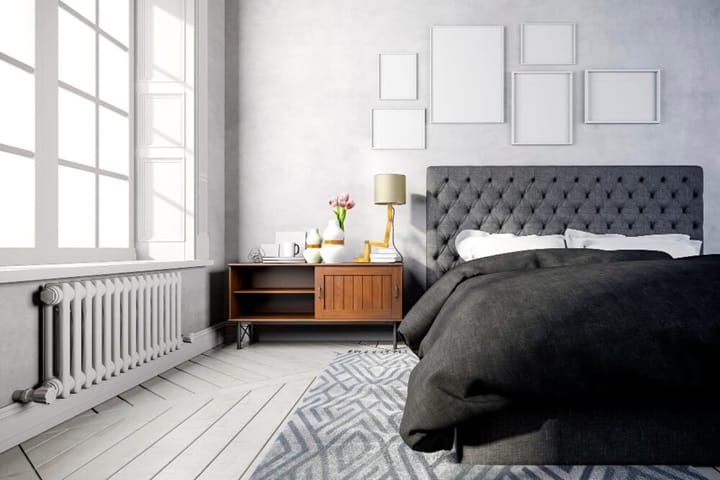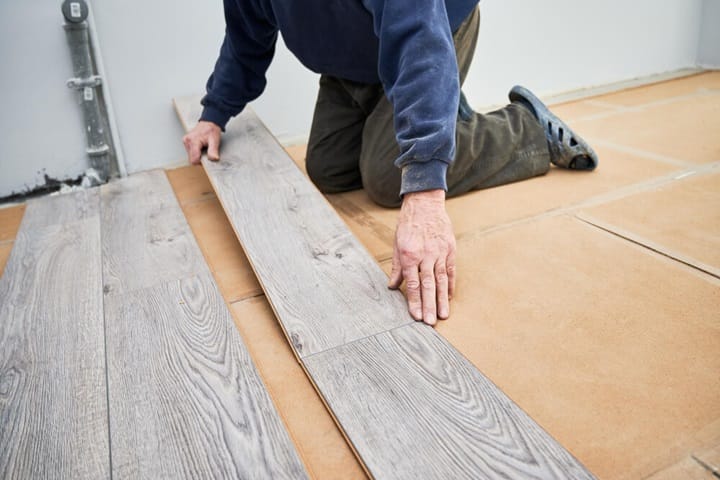Tired of waking up to a chilly bedroom floor? Underfloor heating could be the simple solution you didn’t know you needed. Whether you’re renovating or building a new home, a bedroom with cosy, even heat can make all the difference to your comfort.
As humans, we spend a lot of time in our bedrooms, no matter whether we are sleeping, trying to escape the outdoor world and need time for reflection, or maybe because it’s an area of your home that has its own mini climate, which is both a positive and a negative. Depending on whether your bedroom is north, east, south, or west facing, could impact how warm it actually gets, as well as considering insulation and how much insulation has been installed. Therefore, in this article, we’ll look at how underfloor heating in bedrooms works, the best systems to use, and what it costs to install and run. You’ll also learn how different flooring types affect performance, and why smart controls can make bedtime even better.
Key Points:
- Bedroom underfloor heating provides quiet, consistent warmth from the ground up
- Electric systems are quick to install and ideal for renovations
- Compatible with carpet, laminate, vinyl, and more – with the right setup
- Running costs are low when paired with insulation and smart thermostats
- A great space-saving option compared to bulky radiators
Benefits of Underfloor Heating in a Bedroom
With bedroom underfloor heating, warmth starts at your toes and rises gently, filling the space without cold spots or noisy equipment. A cosy floor first thing in the morning can make getting up far easier—and a cooler-feeling head keeps sleep comfortable through the night.
- Even heat spread: heat rises uniformly across every corner, so no more chilly patches around the skirting.
- Cleaner air: no dust-churning radiators—better for anyone managing asthma or hay fever. Learn about other central heating allergy symptoms.
- Silent running: pipes or cables sit out of sight, so bedtime stays peaceful.
- Smart zoning: warm the nursery or guest room separately without heating the whole house.
- Wake-up timer: pair UFH with a smart stat, and the floor will warm before your alarm goes off.
Because the system works by radiant heat, your ideal temperature often feels comfortable at a lower thermostat setting, helping to trim bills and carbon output. And with the radiator gone, you gain wall space for furniture, storage, or simply a cleaner look.
Still feeling cold spots beyond the bedroom? Find out why your hallway is so cold.
What System Is Best for Your Bedroom?
With our brand, we make choosing underfloor heating kits simple by grouping these by project type:
| Project | Recommended kit | Why it works well |
| Carpet or laminate refurb | Electric underfloor heating kits | Can easily be retrofitted under carpets without needing self-levelling compound |
| Tile, stone, or vinyl overlay | Water underfloor heating kits | Extremely heat reliant and distribution across the surface |
| New-build | Either | Both systems are easier to install during a new build construction |
All kits come pre-sized with the right thermostat, fixing strips, and clear install guide, so your electrician can be in and out in a day for most rooms. Contact us today for more information.
Planning a DIY bedroom project? Read our complete electric underfloor heating installation guide.
Best Floor Finishes for Bedroom Underfloor Heating
Most UK bedrooms still favour carpet, but vinyl planks and engineered wood are growing popular as well due to them being easier to upkeep and maintain. Each floor finish pairs neatly with underfloor heating in bedrooms if you follow a few rules:
- Carpet: keep the combined tog (carpet + underlay) below 2.5. Foil mats spread heat evenly, and a low-tog underlay keeps response time short. Learn more about underfloor heating and carpets.
- Laminate / engineered wood: both mesh and foil mats work. Check the manufacturer’s max surface temperature—usually 27 °C—to protect the board. Understand how laminate underfloor heating can work for you.
- Vinyl (LVT): choose LVT marked “UFH-ready.” Mesh mats perform best; adhesive-backed planks need the floor to reach full cure before turning on.
- Tile or stone: less common in a bedroom, but perfect for a chilly ground-floor suite. Mesh mats deliver the higher watt-density needed to warm dense materials.
Whichever surface you pick, fit insulation boards beneath the heating layer to reflect warmth upward and slash heat-up time.
By matching the right kit to your floor, underfloor heating in bedrooms delivers quiet, controllable comfort—letting you focus on a great night’s sleep instead of cold feet.
Cost of Underfloor Heating in Your Bedroom

When considering the cost of underfloor heating in bedrooms, it’s useful to break it down into three key parts: installation, running costs, and long-term savings.
Installation Costs
Electric underfloor heating systems are the most common choice for bedrooms due to their simplicity of installation. On average, an electric underfloor heating mat (like a mesh or foil mat) will cost around £45–£55 per m². Add to this the price of a thermostat and insulation boards, and you’re looking at roughly £500–£750 to supply a 10m² bedroom setup.
Labour is usually minimal. A qualified electrician can install the mat and connect the thermostat in half a day. This often comes to around £150–£250 depending on location and floor preparation needed.
Water underfloor heating costs more upfront—usually £60–£80 per m²—but this type is better suited to new builds or whole-house systems. Water systems have lower running costs in the long term, especially when used with renewable heat sources like heat pumps. Learn more about how much does underfloor heating cost per m2.
Running Costs
Underfloor heating is often cheaper to run than expected, especially when combined with smart controls and good insulation. Here’s an example of typical electric UFH running costs for a 12 m² bedroom using a 150 W/m² mat:
| Usage Pattern | Annual Energy Use* | Estimated Yearly Cost† |
| 2 hours morning + 4 evening | 680 kWh | £129 |
| 1 hour morning + 2 evening | 340 kWh | £64 |
* Assumes 60% thermostat duty cycle
† Based on £0.19/kWh UK average tariff (Oct 2025)
By adding insulation boards beneath the heating mat, you can reduce energy usage by around 15–20%, as less heat escapes downwards.
Long-Term Value
Compared to radiators, bedroom underfloor heating offers better efficiency at lower temperatures. Radiators heat the air near them first, often leading to overheating the room before feeling warm. With UFH, the heat is spread evenly from the floor up, making the space feel comfortable even at lower thermostat settings.
When paired with a smart energy tariff or low-carbon heat source, many homeowners find that the extra upfront cost pays back in just 3–5 years, particularly for well-used bedrooms.
Installation Tips for Bedroom UFH

Installing underfloor heating is fairly straightforward, especially in a bedroom where layout is simple. That said, there are some tips that make the process smoother and more efficient:
- Check the subfloor: Make sure it’s dry, level, and clean. Any uneven areas may affect the finish or heating coverage.
- Lay insulation boards: These go underneath the heating mat and reflect heat upwards. It makes a huge difference in performance and energy savings. Want better heat-up times and lower energy use? Browse insulation boards for underfloor heating.
- Dry lay the mat first: Plan the layout carefully to avoid placing heating elements under furniture that doesn’t move, such as wardrobes or fitted beds.
- Use a flexible adhesive (if tiling): This allows for expansion and contraction and keeps the heating element safe.
- Don’t skip testing: Your electrician should check resistance and insulation values before and after the floor covering goes down.
For most electric underfloor heating systems like foil or mesh mats, installation can be completed in a single day.
Smart Controls and Thermostats
One of the best features of underfloor heating in bedrooms is the ability to fine-tune your comfort. Smart thermostats for underfloor heating give you precise control over the temperature and timing, so you’re never wasting energy or waking up cold.
Modern thermostats let you:
- Pre-schedule heating: Warm the floor before you get up and let it drop when you’re asleep.
- Control by phone or voice: Use an app, Alexa, or Google Assistant to adjust settings without getting out of bed.
- Track usage: Monitor how much energy you’re using and adjust timings to save money.
- Use adaptive learning: Some smart thermostats learn how quickly your room heats up and adjusts the timing automatically for future days.
By combining a smart thermostat with insulation boards, bedroom underfloor heating becomes one of the most efficient and controllable ways to heat your space—without the bulk of a radiator or the dust they tend to circulate.
Curate a Cosy Bedroom Below Your Very Feet
In conclusion, underfloor heating in bedrooms undeniably offers a warm, quiet, and efficient way to heat your room without the need of radiators; although this is still possible by learning about underfloor heating and radiators. So, whether you’re renovating your home, constructing new rooms, or simply want to retrofit underfloor heating for your bedroom, the benefits are clear—better comfort, cleaner air, and smart temperature control. With the right setup, including insulation boards and a programmable thermostat, bedroom underfloor heating can be both cost-effective and easy to live with for years to come.
Curious about heat imbalance in other parts of your home? This article explains why your house is so hot upstairs.
FAQs
Can you install underfloor heating in a bedroom with carpet?
Yes, as long as the combined tog value of the carpet and underlay is under 2.5.
Is underfloor heating expensive to run in a bedroom?
Not with modern electric systems and insulation – costs are comparable or even lower than radiators when properly controlled.
Sources
Garcia, E., (2023) Why is My House So Hot Upstairs: A Comprehensive Analysis. Retro Foam. [online] Available at: https://www.retrofoam.com/blog/why-is-my-house-so-hot-upstairs [accessed 08/07/2025]
